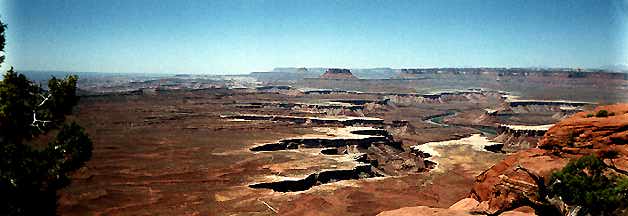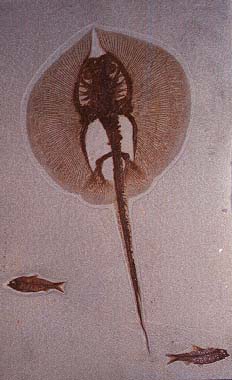| Below is a view of the Green River Formation in Utah. The
Green River Formation covers 25,000 square miles, and on the average, it
is 2,000 feet deep. It covers portions of Wyoming, Colorado and Utah. |

|
| An important source for fossil fish specimens in America is in Kemmerer,
Lincoln County, Wyoming. The fossils are dated to the Eocene Age
(+40 million years old). This fossil rich area was once the sight
of several fresh water lake systems located in an area with a climate that
was comparable to the present day Gulf Coast. Below are some of the
finds that have come from this area and were available through retail outlets.
None of these examples were found by us. |
   
|
| Here are two nice images of fossils for Heliobatis radians, which
are nice examples of ray fossils. Many a collector would love to
have these, if they are lucky enough to find one, or if they could afford
the purchase price. |
 
|
| One last fossil image we thought we would provide you has a little
irony in it. Though they say it is a “dog eat dog world” out there,
this image proves that this world is a little more than that. |

|
| There is one other area concerning fossil fish collecting that people
like to participate in. If you went up to someone and said that you
like to collect fossil fish teeth, people would probably look at you a
little funny, because they are thinking of the spiny little teeth that
they have seen from their own fishing experiences. However, if you
said you collected fossil shark teeth, you would see people’s eyes light
up most of the time. Though sharks are fish, people do not seem to
think of them as such, which may have to do with the fish people catch
not being aggressive like sharks. Of course, the size of sharks probably
has a lot to do with it as well. To see examples of shark’s teeth,
just click on the icon below. |

|







 The
History House.
The
History House.
 RETURN
TO THE HISTORY HOUSE HOME PAGE
RETURN
TO THE HISTORY HOUSE HOME PAGE
